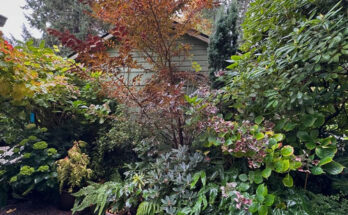Why is it that the first warm day brings out homeowners with their pruning shears to snip here, snip there without much rhyme or reason?

Pruning Tips to Remember
- Remember, spring-blooming trees and shrubs should be left alone until after they have bloomed or you may cut off all the flower buds.
- Shrubs that bloom in July or later can be pruned now (March). Awkward branches may be removed at any time.
- If a branch is over one-half inch in diameter better use lopping shears or a saw rather than a good pair of pruning shears.
As a side note there is also a “Best Time” to spray for bugs – more.
Basic Pruning Cuts
Here are the 4 different types of “pruning cuts” used for different purposes. These techniques can be combined can help you achieve the desired shape and health of your trees and shrubs.
Heading Cuts
- Purpose: To remove the top portion of a branch, cutting back to a specific bud.
- Method: Cut about one quarter of an inch above a bud at a 45-degree angle.
- Result: Stimulates the buds beneath the cut to become new branches, which is beneficial for flowering shrubs and fruit trees as it can lead to more buds, flowers, and fruit.
- Consideration: Avoid heading cuts if the aim is to open up a plant, as they can increase density.

Thinning Cuts
- Purpose: To remove entire branches within a tree or shrub, thinning out the interior.
- Method: Cut just outside the enlarged collar at the base of the branch without leaving a stub or cutting into the collar.
- Result: Directs energy up the main branch, promoting stronger growth and opening up the plant to more light and air.
- Consideration: Thinning cuts may cause a tree or shrub to grow taller or wider than desired if lead branches are left intact.
If you click this link and make a purchase, we earn a commission at no additional cost to you.
Re-leadering Cuts
- Purpose: To remove part of a lead branch above a lateral, making the lateral the new lead.
- Method: Cut no more than one-quarter of an inch above where the main branch meets the lateral at an angle between straight across and the slope of the lateral.
- Result: Reduces the height and width of trees and shrubs, and slows their growth.
- Consideration: The lateral must be at least one-third the diameter of the main branch to support its new role.
Jump Cuts
- Purpose: To reduce the weight of a branch before making a final cut to prevent tearing.
- Method: Three-part cut sequence – an initial undercut one-third to one-half way through the branch, a top cut one-half to one inch further out, followed by the final cut just outside the branch collar.
- Result: Safely removes heavy branches without damaging the plant.
Spring Pruning is Crucial
Spring pruning is a crucial gardening task that ensures the health and beauty of your plants. The timing and method of pruning depend on the type of plant you’re dealing with.
Source link




